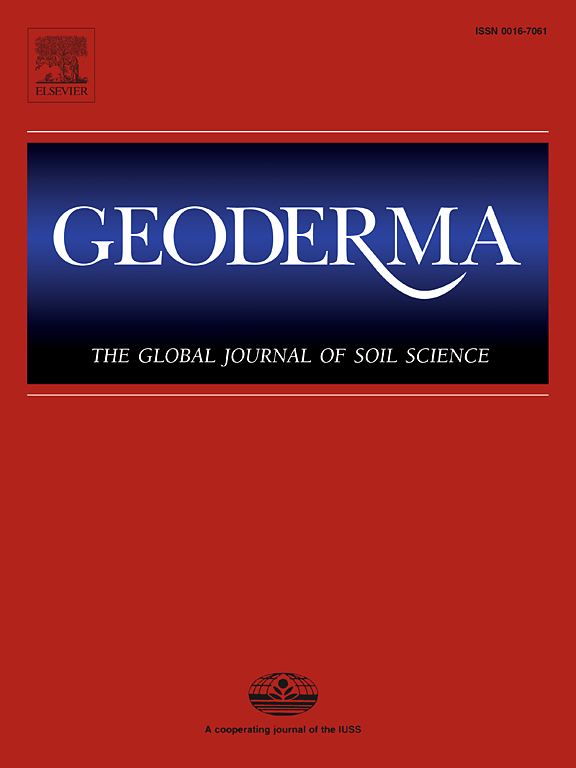森林土壤呼吸表现出饱和阈值,以响应氮沉降的增加:来自中生态实验的证据
IF 5.6
1区 农林科学
Q1 SOIL SCIENCE
引用次数: 0
摘要
在森林生态系统中,土壤呼吸(Rs)对氮沉降的响应是否存在一个氮饱和阈值尚不清楚。本文在杉木幼树的介环境实验平台上进行了模拟N沉降试验,试验涉及5个水平的N添加(0 ~ 44.8 g N m−2 yr−1)。测量了4年的Rs及其自养(Ra)和异养(Rh)分量,并采用二次+平台模型估计了N饱和阈值。随着N添加速率的增加,Rs和Ra首先急剧增加,分别达到临界N添加速率12.2和13.6 g N m−2 yr−1,然后趋于平稳。添加N后,树木生长也出现了类似的非线性增长。相反,随着N添加量的增加,Rh继续降低,这主要是由于N增加了土壤有机C的抗性,这可以从革兰氏阴性菌生物量的减少和多酚氧化酶活性的增加中得到证明。结果表明:(1)土壤呼吸存在一个氮饱和阈值,在此阈值之前,土壤呼吸速率随着氮的增加而增加,之后增加的速率逐渐消失;(2)土壤呼吸的氮饱和阈值受自养而非异养呼吸驱动。本研究有助于进一步了解森林碳循环对生长氮沉降的响应。本文章由计算机程序翻译,如有差异,请以英文原文为准。
Forest soil respiration showed a saturation threshold in response to increasing nitrogen deposition: Evidence from a mesocosm experiment
Whether there is a N saturation threshold for the response of soil respiration (Rs) to increasing nitrogen (N) deposition remains unclear in forest ecosystems. In this work, a simulated N deposition experiment involving five levels of N addition (0 to 44.8 g N m−2 yr−1) was performed in a mesocosm experiment platform with young Chinese fir (Cunninghamia lanceolata) trees planted on it. Rs and its autotrophic (Ra) and heterotrophic (Rh) components were measured for four years, and the N saturation threshold was estimated using a quadratic-plus-plateau model. With increasing rate of N addition, Rs and Ra first increased dramatically until the critical N addition rate of 12.2 and 13.6 g N m−2 yr−1, respectively, and then leveled off. A similar non-linear increase in tree growth was also detected with N addition. In contrast, Rh continued to decrease as N addition increases, primarily a consequence of the N-increased recalcitrance of soil organic C, as evidenced by the decreased gram-negative bacteria biomass coupled with increased polyphenol oxidase activity. Our results indicated (1) that there was a N saturation threshold for the soil respiration, before which respiration rate increased with N addition and such an increase vanished thereafter; and (2) that the N saturation threshold of soil respiration was driven by autotrophic rather than heterotrophic respiration. This study advanced our understanding of the response of forest carbon cycle to growing N deposition.
求助全文
通过发布文献求助,成功后即可免费获取论文全文。
去求助
来源期刊

Geoderma
农林科学-土壤科学
CiteScore
11.80
自引率
6.60%
发文量
597
审稿时长
58 days
期刊介绍:
Geoderma - the global journal of soil science - welcomes authors, readers and soil research from all parts of the world, encourages worldwide soil studies, and embraces all aspects of soil science and its associated pedagogy. The journal particularly welcomes interdisciplinary work focusing on dynamic soil processes and functions across space and time.
 求助内容:
求助内容: 应助结果提醒方式:
应助结果提醒方式:


